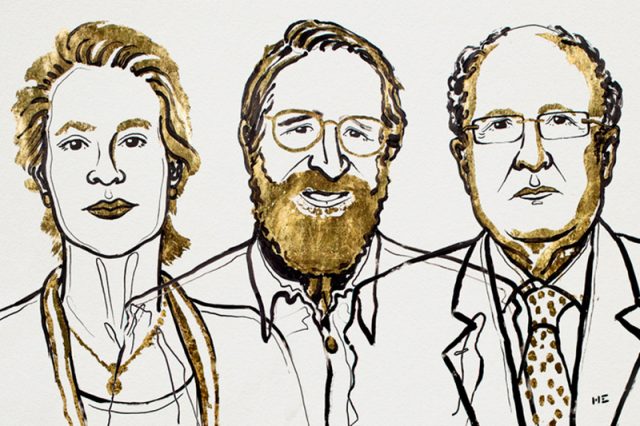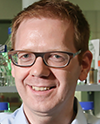This year’s Chemistry Nobel Prize was awarded co-jointly to three outstanding scientists (Frances Arnold, George Smith and Gregory Winter) for their work on directed evolution of enzymes and phage display technology. The Nobel Prize highlighted the tremendous role of chemistry at the interface with biology in bringing innovation in the biological world or medecine. During the course of their careers, they trained and worked with numerous PhD students and postdocs. We met with Prof. Armedis Boghossian, former postdoc in Frances Arnold’s lab, and Prof. Christian Heinis, former postdoc in Sir Greg Winter’s lab, and asked them to reveal some aspects of their experience working with these two 2018 Chemistry Nobel Prize winners. Is a Nobel Prize just the conclusion of a long and quiet quest perhaps not so different from any other lab?

Interview with Ardemis Boghossia, Tenure Track Assistant Professor at EPFL
Why did you join the Arnold lab?
I am a chemist first. After obtaining my Bachelor’s degree in Chemical Engineering, I started a PhD in nanomaterials to study their electronic properties. The goal of my graduate work was to develop optical nanosensors by using different kinds of materials. We were basically looking for a polymer that would be capable of interacting with biological constructs to enhance solar energy conversion. At the beginning of my PhD, I thought biology was too complex and quite messy. However, I soon realized that it is in biology that you find the most selective tools. The best way to bind a chosen ligand is to use a protein for it. So I decided to go and learn about protein engineering in Frances Arnold’s lab.
I arrived in Frances lab with my own project, which was different from what the rest of the group was doing. Her work focused mostly on P450 proteins and on rhodopsins. When I started, I had to spend the first few months learning all the basic biology techniques, like cloning. It was tough, but I made it! At the end of my first year, I had established a robust assay and I could start with the actual directed evolution of my protein.
Was there anything special in Arnold’s lab?
The lab was highly interdisciplinary. Most people were chemists with different backgrounds, and a few biologists. I think Frances understands very well the importance of multidisciplinarity as she has a bachelor’s degree in mechanical and aerospace engineering. She worked in solar energy before earning a PhD in chemical engineering. And now she won the 2018 Chemistry Nobel Prize! That shows the importance of multidisciplinarity to understand our world and to develop new tools.
One key lesson you learned during these years?
There was a saying going around in the lab: “you get what you screen for”. It’s very simple and at the same time it is absolutely true.
If your goal is to obtain a sensor of protein X, and you use a homologue of protein X in your screen, you’ll end up with a very good sensor for the homologue, which might not be as good against the initial protein. This saying shows the complexity and importance of designing a carefully thought screen.
How do you use today what you learned during your postdoc?
In my lab, we are combining nanotechnologies and protein engineering. We use the advantages of both fields to develop new technologies for biosensing and light-harvesting applications. Indeed, while proteins are highly selective compared to any synthetic sensor, they are rapidly degraded by photobleaching. On the other hand, nanomaterials have interesting photophysical and electronic properties and are more resistant. We are looking for synergies between these two fields in order to achieve our goals.
What do you think about Frances Arnold receiving the 2018 Chemistry Nobel Prize?
I was very excited, because I know she truly deserves it. But I also thought “why only now”? I think it should have come earlier. It took some time at the beginning for people to recognize the potential of her method and the power of directed evolution.
Interview with Christian Heinis, Associate Professor at EPFL
Why did you choose the lab of Sir Greg Winter for a postdoc?
I knew about the impressive work of Greg Winter from my PhD with Dario Neri at the Institute of Pharmaceutical Sciences ETH Zurich where I was exposed to the antibody engineering field. We had attempted to use phage display to evolve properties of enzymes, which by the way never really worked so well. Additionally, Dario was a former postdoc in Greg’s lab and was always speaking highly of him. So I had information about the lab from first hand. Following a first postdoc in the research group of Prof. Kai Johnsson at EPFL, I then decided to apply for a postdoc there, and with the help of supporting letters from my supervisors, I got an invitation from Greg for an interview. During my visit of the group, I proposed to generate bicyclic peptides by phage display to make molecules that mimic the binding face of antibodies but have a much smaller size. Greg liked the approach and offered me to come and develop it in his lab.
Was there something special about Sir Winter’s lab?
At the time I joined the lab, Greg Winter had already reduced a bit the size of his team. Actually, I was his last postdoc. We were three postdocs and several older, very experienced and talented scientists, including a lab manager, a senior scientist, a professor on a sabbatical writing a book, and a retired professor. This was a very inspiring environment and I learned much from all team members.
One key lesson you learned during these years?
What always impressed me in Greg Winter’s lab and at the LMB in general was that most scientists had a “big plan” in mind. They were determined to answer an important scientific question or to solve a longstanding technical or medical problem. I think that it is a great approach to start research, by defining first an important goal.
I follow this with my own research team: our current “big plan” is to develop orally available or even cell permeable (peptide) macrocycles that bind targets of choice, including protein targets to which classical small molecule drugs could not be generated.
How do you use today what you had developed or learned during your postdoc?
My lab has extensively used the bicyclic peptide phage display technology that I had developed with Greg Winter. This has led to several cyclic peptides that we are currently testing in disease models.
What do you think about Greg Winter receiving the 2018 Chemistry Nobel Prize?
It was touched and happy when I heard about it. While I was expecting that Greg would get a Nobel Prize, it was still a special moment when it happened. He deserves it so much!
 Ardemis Boghossian is appointed a Tenure Track Assistant Professor at EPFL since 2015 in the Institute of Chemical Science and Engineering. In her laboratory, she combines protein engineering and nanotechnologies for developing a new generation of nano-bionic devices for light-harvesting and biosensing applications. From 2012 to 2014, she was a postdoc in the research group of the 2018 Chemistry Nobel Prize winner, Frances H. Arnold.
Ardemis Boghossian is appointed a Tenure Track Assistant Professor at EPFL since 2015 in the Institute of Chemical Science and Engineering. In her laboratory, she combines protein engineering and nanotechnologies for developing a new generation of nano-bionic devices for light-harvesting and biosensing applications. From 2012 to 2014, she was a postdoc in the research group of the 2018 Chemistry Nobel Prize winner, Frances H. Arnold.
 Christian Heinis is an Associate Professor at the Institute of Chemical Science and Engineering of EPFL since 2015 and is also co-director of the NCCR Chemical Biology. His laboratory aims at developing therapeutics based on cyclic peptides. A major focus of his lab is the phage display selection of bicyclic peptides, a technology that he developed as a postdoc at the Laboratory of Molecular Biology (LMB) in Cambridge, UK, together with Sir Greg Winter, a winner of the 2018 Chemistry Nobel Prize.
Christian Heinis is an Associate Professor at the Institute of Chemical Science and Engineering of EPFL since 2015 and is also co-director of the NCCR Chemical Biology. His laboratory aims at developing therapeutics based on cyclic peptides. A major focus of his lab is the phage display selection of bicyclic peptides, a technology that he developed as a postdoc at the Laboratory of Molecular Biology (LMB) in Cambridge, UK, together with Sir Greg Winter, a winner of the 2018 Chemistry Nobel Prize.
Cover illustration: Niklas Elmehed. Copyright: Nobel Media AB 2018.

Leave a comment
The editors reserve the right not to publish comments or to abridge them.
Professor Prem raj Pushpakaran
2021 marks the birth centenary year of Robert Bruce Merrifield!!!